by Katherine Somerby, Communications & Development Coordinator
Submerging ourselves in different perspectives ultimately enriches our work, and nothing facilitates that like delving into a good book. As the bears take to their dens for a long winter’s nap, we nestle into armchairs with blankets and a good book in our lap.
Atop my rickety nightstand lay several books: Barbara Kingsolver’s Demon Copperhead, a collection of F. Scott Fitzgerald’s drinking tales and one-liners titled On Booze, some Pablo Neruda love poems to warm your ticker—all of which I peruse through ploddingly for pleasure. I’m neither fast nor slow at reading; call it middle ground. I imagine my bedside table mirrors many others who wonder where all the time goes by the end of the day to just read. So we must make the time, prioritize the time.
I was curious what my fellow staff members are reading once the workday ceases, so I asked them what’s atop their nightstands. Some are about facets of our natural world, and others may be for those times when we need a break from thinking about environmental challenges.
Melissa Butynski, International Connectivity Project Specialist
Crossings by Ben Goldfarb
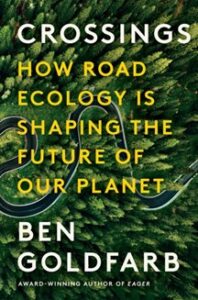 Very rarely do I stray away from the comfort of fiction. My day is filled with reading about the stark realities of conservation in an increasingly tumultuous world, so I prefer my leisure reading to offer a heavy-handed amount of escapism. I will, however, make an exception for one of my favorite environmental journalists writing about one of my favorite conservation topics. Crossings by Ben Goldfarb is a witty and engaging deep dive into the collisions between wildlife and society (literally). Crossings highlights the environmental and societal costs of these collisions and the many solutions available to us. Ben covers a complex topic well, offering an incredible range of relatable anecdotes. Next time someone asks me what I do for a living, I will hand them this instead!
Very rarely do I stray away from the comfort of fiction. My day is filled with reading about the stark realities of conservation in an increasingly tumultuous world, so I prefer my leisure reading to offer a heavy-handed amount of escapism. I will, however, make an exception for one of my favorite environmental journalists writing about one of my favorite conservation topics. Crossings by Ben Goldfarb is a witty and engaging deep dive into the collisions between wildlife and society (literally). Crossings highlights the environmental and societal costs of these collisions and the many solutions available to us. Ben covers a complex topic well, offering an incredible range of relatable anecdotes. Next time someone asks me what I do for a living, I will hand them this instead!
Kylie Paul, Road Ecologist
Underworld: Journeys to the Depths of the Ocean by Susan Casey
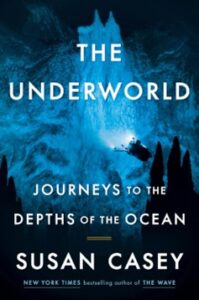 I am midway through reading The Underworld: Journeys to the Depths of the Ocean by Susan Casey, and holy cow, what a new world I’ve been exposed to – the bottom of the ocean and those brave enough to explore it. Not too long ago, the world thought nearly nothing lived at these tremendous depths, but in fact, an incredibly diverse and beautiful ecosystem thrives in the abyss. We can name every nook and cranny of the moon and many other planets, but humans have only explored and mapped FIVE PERCENT of the ocean and its depths. Frustratingly, like many natural resources, without understanding it, we still seek to plunder what we can from it. Meanwhile, not only are the creatures living in the deep entirely intriguing, but the people leading the way to research the depths are outliers. They are intensely high achievers and driven to undertake the massive risks of extraordinarily high pressures (both physical and mental) of deep-sea diving. I can’t wait to finish this book.
I am midway through reading The Underworld: Journeys to the Depths of the Ocean by Susan Casey, and holy cow, what a new world I’ve been exposed to – the bottom of the ocean and those brave enough to explore it. Not too long ago, the world thought nearly nothing lived at these tremendous depths, but in fact, an incredibly diverse and beautiful ecosystem thrives in the abyss. We can name every nook and cranny of the moon and many other planets, but humans have only explored and mapped FIVE PERCENT of the ocean and its depths. Frustratingly, like many natural resources, without understanding it, we still seek to plunder what we can from it. Meanwhile, not only are the creatures living in the deep entirely intriguing, but the people leading the way to research the depths are outliers. They are intensely high achievers and driven to undertake the massive risks of extraordinarily high pressures (both physical and mental) of deep-sea diving. I can’t wait to finish this book.
Gabe Oppler, International Connectivity Program, Policy & Partnerships Specialist
Northwoods by Daniel Mason
 Last fall, I joined my first-ever book club, which feels like a rite of passage (I’m a real adult now!) Our first pick was Demon Copperhead, which was probably my favorite book of all time. Now with high expectations, we’ve plunged into Northwoods by Daniel Mason. It’s historical fiction, a genre I love because I can connect with characters who serve as a guide to another time and place. Northwoods traces the history of a cabin in the woods of western Massachusetts. The story arc follows the cabin’s inhabitants (human, animal, and spirit) across nearly 500 years. I’ve only made it to the late 1800s, but I’ve already met a rebellious Puritan couple, an industrious apple orchardist, and a despicable slave catcher. Narrative vignettes are punctuated by poems, letters, and paintings. As someone who works on land use policy, it’s especially interesting to read about the changes the characters have brought to the landscape – felling timber, sowing crops, splicing apple scions, and building homes. I’m excited to see how this story develops. With sub-zero temperatures on the horizon here in Montana, I have a feeling I’ll reach the end of this book soon!
Last fall, I joined my first-ever book club, which feels like a rite of passage (I’m a real adult now!) Our first pick was Demon Copperhead, which was probably my favorite book of all time. Now with high expectations, we’ve plunged into Northwoods by Daniel Mason. It’s historical fiction, a genre I love because I can connect with characters who serve as a guide to another time and place. Northwoods traces the history of a cabin in the woods of western Massachusetts. The story arc follows the cabin’s inhabitants (human, animal, and spirit) across nearly 500 years. I’ve only made it to the late 1800s, but I’ve already met a rebellious Puritan couple, an industrious apple orchardist, and a despicable slave catcher. Narrative vignettes are punctuated by poems, letters, and paintings. As someone who works on land use policy, it’s especially interesting to read about the changes the characters have brought to the landscape – felling timber, sowing crops, splicing apple scions, and building homes. I’m excited to see how this story develops. With sub-zero temperatures on the horizon here in Montana, I have a feeling I’ll reach the end of this book soon!
Megan Parker, Conservation Project Director
Sex Advice to All Creation by Olivia Judson
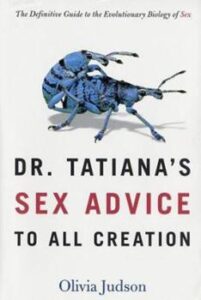 I’ve become that annoying reader who has several books going at once; something challenging and new is The Lost Journals of Sacajewea by Debra Magpie Earling—which I highly recommend)—some chapters easily consumed before I sleep, and an old favorite that I can pick up and put down knowing I will be in a better frame of mind. Sex Advice to All Creation is that book. Olivia Judson is an evolutionary biologist who writes of mating behavior across the animal kingdom in Dear Abby style, with species writing in asking for help. Imagine the plight of the male praying mantis and the help he needs navigating his girlfriend’s moods. It is incredibly entertaining, thoughtful, intellectual, and nerdy.
I’ve become that annoying reader who has several books going at once; something challenging and new is The Lost Journals of Sacajewea by Debra Magpie Earling—which I highly recommend)—some chapters easily consumed before I sleep, and an old favorite that I can pick up and put down knowing I will be in a better frame of mind. Sex Advice to All Creation is that book. Olivia Judson is an evolutionary biologist who writes of mating behavior across the animal kingdom in Dear Abby style, with species writing in asking for help. Imagine the plight of the male praying mantis and the help he needs navigating his girlfriend’s moods. It is incredibly entertaining, thoughtful, intellectual, and nerdy.
Katherine Somerby, Communications & Development Coordinator
All We Can Save by Dr. Ayana Elizabeth Johnston
She Had Some Horses by Joy Harjo
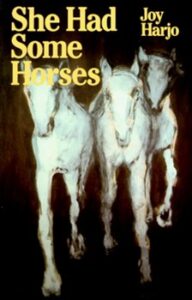 As part of my CLLC book club for Racial Justice and Climate Equity, I am reading All We Can Save by Dr. Ayana Elizabeth Johnston: a collection of poetry, short stories, and essays—by all women writers—that light a path forward amid this climate crisis. I highly recommend it for a wide range of readers and ages, as we need as many coping mechanisms as possible to endure what feels like an insurmountable calamity. It’s brought me peace, but what soothes me in the morning or at night is Joy Harjo’s She Had Some Horses. Harjo’s poetry grapples with womanhood, the despair of womanhood, the disconnect between nature and society, her lens as a Native American, and the beckoning, estranged homeland that calls.
As part of my CLLC book club for Racial Justice and Climate Equity, I am reading All We Can Save by Dr. Ayana Elizabeth Johnston: a collection of poetry, short stories, and essays—by all women writers—that light a path forward amid this climate crisis. I highly recommend it for a wide range of readers and ages, as we need as many coping mechanisms as possible to endure what feels like an insurmountable calamity. It’s brought me peace, but what soothes me in the morning or at night is Joy Harjo’s She Had Some Horses. Harjo’s poetry grapples with womanhood, the despair of womanhood, the disconnect between nature and society, her lens as a Native American, and the beckoning, estranged homeland that calls.
Aaron Laur, International Connectivity Program, Policy & Partnerships Manager
Dead Cities, and Other Tales by Mike Davis
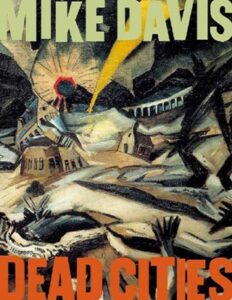 I recently went back to my collection of books from undergraduate studies at the University of Wyoming, which included Dead Cities and Other Tales by Mike Davis. If not evident from the title, readers beware that these vignettes are often astounding and downright troubling. A number of the chapters—with engaging writing and ample footnotes—can help dispel the myth of the wild, unspoiled western United States and illustrate the reality of an ongoing legacy of deception, destruction, and delusion that will continue to plague our people and ecosystems. Have you heard about the replica German houses constructed on the U.S. Army’s Dugway Proving Ground in Utah that helped perfect incendiary bombing techniques to burn out the populations of Berlin, Dresden, and Leipzig during World War II? If not, this is the book for you. Have you heard about the Navy’s “Bravo 20” site in Nevada that belched radioactive clouds from atmospheric and underground nuclear detonations and poisoned scores of communities downwind of the site over decades? If not, this is the book for you.
I recently went back to my collection of books from undergraduate studies at the University of Wyoming, which included Dead Cities and Other Tales by Mike Davis. If not evident from the title, readers beware that these vignettes are often astounding and downright troubling. A number of the chapters—with engaging writing and ample footnotes—can help dispel the myth of the wild, unspoiled western United States and illustrate the reality of an ongoing legacy of deception, destruction, and delusion that will continue to plague our people and ecosystems. Have you heard about the replica German houses constructed on the U.S. Army’s Dugway Proving Ground in Utah that helped perfect incendiary bombing techniques to burn out the populations of Berlin, Dresden, and Leipzig during World War II? If not, this is the book for you. Have you heard about the Navy’s “Bravo 20” site in Nevada that belched radioactive clouds from atmospheric and underground nuclear detonations and poisoned scores of communities downwind of the site over decades? If not, this is the book for you.
Rob Ament, Senior Conservationist
The Undertakers Widow by Phillip Margolin
 The book I am reading I wouldn’t recommend to anyone unless you like cheesy whodunits. The Undertaker’s Widow by Phillip Margolin is a story not worth repeating. Why, you ask, am I reading it then? Commitment! Once taken up, I always read a book cover to cover. I picked this one out in a used bookstore in Chiang Mai, Thailand, literally at the bottom of a barrel of English language paperbacks. I was desperate and in immediate need of a mindless read for the twenty-plus hours of flight time to get home, never mind all the hours languishing at three layovers. I now proudly consider myself a detritus feeder of literary leftovers. My equivalent in nature, decomposers, are indispensable, keeping the cycle of life and nutrients spinning round and round. They don’t receive much attention, are often dismissed as uninteresting, but their role is essential. I am now one of their brethren for the literary glitterati. My forlorn book will soon appear in my neighbor’s lending library box along her front sidewalk to keep it in rotation. So I am not recommending this specific book as much as the act of sharing, reusing, and recycling the books we read!
The book I am reading I wouldn’t recommend to anyone unless you like cheesy whodunits. The Undertaker’s Widow by Phillip Margolin is a story not worth repeating. Why, you ask, am I reading it then? Commitment! Once taken up, I always read a book cover to cover. I picked this one out in a used bookstore in Chiang Mai, Thailand, literally at the bottom of a barrel of English language paperbacks. I was desperate and in immediate need of a mindless read for the twenty-plus hours of flight time to get home, never mind all the hours languishing at three layovers. I now proudly consider myself a detritus feeder of literary leftovers. My equivalent in nature, decomposers, are indispensable, keeping the cycle of life and nutrients spinning round and round. They don’t receive much attention, are often dismissed as uninteresting, but their role is essential. I am now one of their brethren for the literary glitterati. My forlorn book will soon appear in my neighbor’s lending library box along her front sidewalk to keep it in rotation. So I am not recommending this specific book as much as the act of sharing, reusing, and recycling the books we read!



